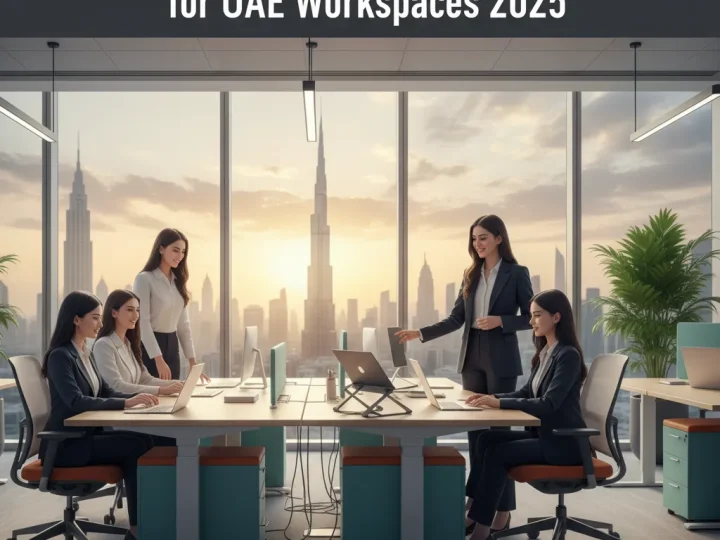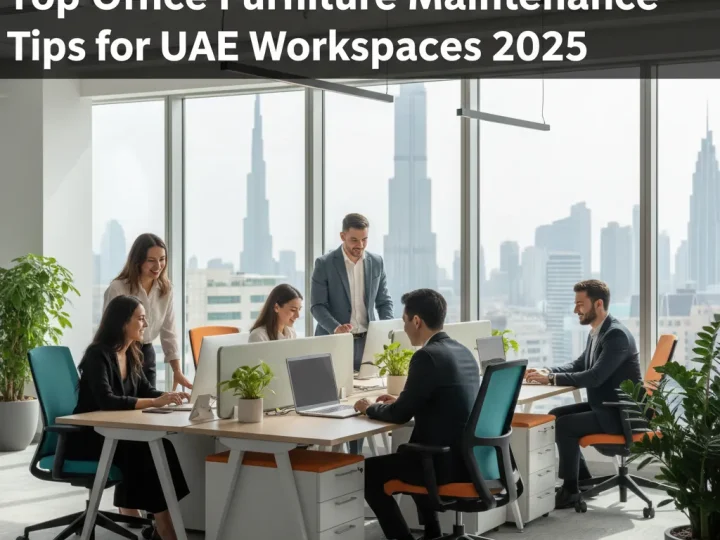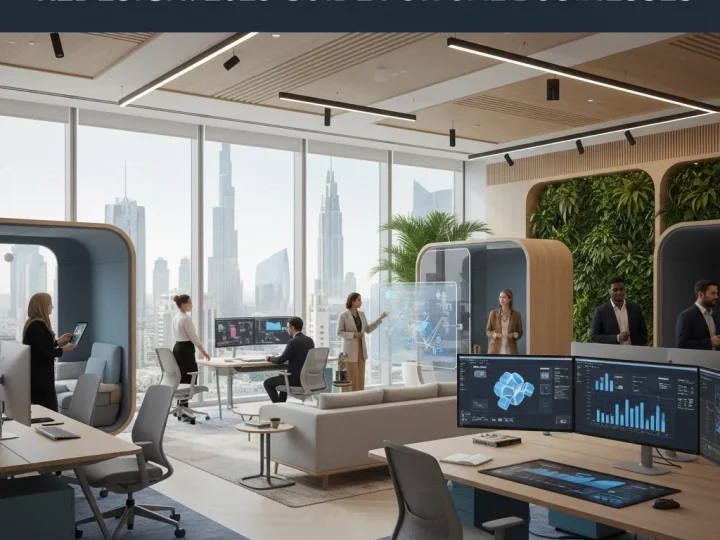

The array of furniture choices in modern workplaces is more crucial than ever. Research shows that flexible, modular furniture can increase collaboration by up to 30 percent. But here’s the twist: the way people work today is often at odds with the conventional office setup. As companies embrace hybrid work models, traditional furniture solutions simply don’t cut it anymore. Instead, innovative designs that adapt to various work styles are taking center stage, transforming offices into vibrant, productive environments.
Table of Contents
- Understanding Office Space Needs
- Choosing Furniture For Collaboration
- Furniture Options For Focus Areas
- Selecting Furniture For Meeting Rooms
Quick Summary
| Takeaway | Explanation |
|---|---|
| Modular and Flexible Furniture | Furniture that can be quickly reconfigured is essential to support diverse workplace needs, enhancing collaboration and individual work styles in modern office designs. |
| Technology Integration in Meeting Spaces | Modern meeting room furniture should incorporate smart features like built-in charging stations and interactive elements to facilitate effective in-person and virtual collaboration. |
| Focus on Ergonomics | Ergonomic furniture solutions are necessary for maintaining employee health and concentration, incorporating adjustable features that reduce strain during work tasks. |
| Tailored Design for Organizational Needs | Successful office layouts should reflect an organization’s culture and work processes, utilizing innovative furniture designs that encourage collaboration and productivity. |
Understanding Office Space Needs
Navigating the complex landscape of modern office design requires a strategic approach to furniture selection that goes beyond aesthetic considerations. Furniture for different office types has become a critical element in creating productive, flexible, and employee-centric work environments.
The Evolution of Workspace Design
Today’s office spaces are dramatically different from traditional corporate settings. Organizations now recognize that one-size-fits-all furniture solutions are ineffective. Research from K2 Space indicates that modular and flexible furniture is foundational to meeting diverse workplace needs in 2025, enabling rapid reconfiguration to support collaborative, private, and hybrid work models.
The shift reflects a deeper understanding of how physical environments impact employee productivity, creativity, and overall well-being. Companies are investing in furniture that adapts to changing work dynamics, supporting different work styles and organizational requirements.
Designing for Flexibility and Functionality
Adaptable furniture has become more than a trend—it’s a strategic necessity. Workplace design experts emphasize that furniture designed for adaptability directly supports hybrid work models, increasing productivity and employee satisfaction. This means incorporating elements like:
- Modular desks that can be quickly reconfigured
- Adjustable ergonomic chairs supporting individual comfort
- Multipurpose workstations that facilitate seamless transitions between solo and collaborative work
The goal is creating environments that empower employees to choose how and where they work most effectively. By investing in versatile furniture solutions, organizations can create spaces that are not just functional but also inspiring.
Tailoring Spaces to Organizational Needs
Understanding furniture for different office types requires a nuanced approach. Startup environments might prioritize open, collaborative spaces with flexible seating, while traditional corporate offices might need more structured configurations. Interior design research suggests that innovative design solutions like hexagonal or modular desks can facilitate smooth transitions between various work activities.
Successful office design isn’t about following trends blindly but about creating purposeful environments that reflect an organization’s culture, work processes, and employee needs. The right furniture can transform a generic space into a dynamic, productive ecosystem that supports innovation, collaboration, and individual performance.
Choosing Furniture for Collaboration
Collaboration is the cornerstone of modern workplace productivity, and selecting the right furniture can dramatically transform how teams interact, communicate, and generate innovative solutions. Furniture for different office types plays a pivotal role in creating spaces that naturally encourage teamwork and creative exchange.
The New Landscape of Collaborative Furniture
Workplace design experts highlight that collaborative desks represent a significant shift from traditional workstations, designed specifically to facilitate dynamic team interactions. These aren’t just pieces of furniture—they’re strategic tools that reshape how professionals connect and collaborate.
Modern collaborative furniture goes beyond simple functionality. It’s about creating environments that break down physical and psychological barriers between team members, promoting open communication and spontaneous idea sharing. The design philosophy emphasizes flexibility, mobility, and adaptability.
Innovative Conference and Meeting Spaces
Contemporary office furniture trends showcase an evolution in conference table designs. Gone are the days of rigid, imposing rectangular tables that create hierarchical spaces. Instead, circular, oval, and modular tables are emerging as preferred choices that create more egalitarian and interactive meeting environments.
Smart conference tables now come equipped with technological integrations that enhance collaboration. Features like built-in USB ports, HDMI outputs, and sophisticated cable management systems transform traditional meeting spaces into high-tech collaboration hubs. These tables aren’t just furniture—they’re communication platforms that support seamless digital and in-person interactions.
Creating Adaptive Collaborative Environments
The key to effective collaborative furniture lies in its adaptability. Interior design research suggests that modular furniture solutions offer unprecedented flexibility for modern workspaces. Stackable chairs, foldable tables, and reconfigurable workstations allow organizations to quickly transform spaces to suit different team dynamics and project requirements.
Consider creating dedicated collaboration zones with furniture that encourages spontaneous interactions. This might include high-top tables for quick discussions, lounge-style seating for informal brainstorming, and movable partition systems that can quickly create semi-private collaborative spaces. The goal is to design environments that feel both professional and approachable, breaking down traditional workplace barriers.
By thoughtfully selecting furniture that supports collaboration, organizations can create workplace environments that not only facilitate teamwork but also inspire creativity, foster innovation, and reflect a progressive, dynamic corporate culture.
Furniture Options for Focus Areas
In the modern workplace, focus areas represent critical spaces where individual productivity and deep work can flourish. Furniture for different office types must strategically support concentration, minimize distractions, and create environments that enable employees to perform complex cognitive tasks effectively.
Designing Distraction-Free Workspaces
Office design research reveals that sound masking technology and customizable furniture are becoming essential in creating effective focus zones. These innovations help minimize environmental disruptions while providing employees with personalized work environments that enhance concentration.
The key is creating furniture solutions that offer both privacy and flexibility. Movable partitions, acoustic panels, and strategic furniture placement can transform open office layouts into environments that support individual productivity. By understanding that focus is a nuanced psychological state, organizations can design spaces that actively support mental clarity and deep work.
Ergonomic Solutions for Sustained Concentration
Workplace ergonomics experts emphasize that furniture in focus areas must prioritize physical comfort to maintain cognitive performance. Height-adjustable desks, ergonomic chairs with advanced lumbar support, and standing work configurations are no longer luxuries but necessities for maintaining employee health and productivity.

Ergonomic furniture goes beyond basic comfort. It’s about creating environments that reduce physical strain, prevent repetitive stress injuries, and allow employees to maintain high levels of concentration for extended periods. Features like adjustable monitor arms, keyboard trays, and dynamic seating options enable workers to customize their workspace according to individual preferences.
Modular Furniture for Adaptive Focus Environments
Workplace design research highlights the growing importance of modular furniture in creating flexible focus areas. Furniture that can be quickly reconfigured allows organizations to adapt spaces rapidly, supporting different work styles and individual concentration needs.
Modular furniture solutions might include portable privacy screens, compact workstations with integrated power outlets, and furniture pieces that can be easily repositioned to create temporary individual work zones. The goal is to provide employees with the autonomy to create personalized focus environments that align with their specific tasks and working preferences.
By thoughtfully selecting furniture that supports individual concentration, organizations can create focus areas that are not just functional spaces, but psychological sanctuaries that enable deep work, creativity, and sustained high performance.
Selecting Furniture for Meeting Rooms
Meeting rooms are the strategic nerve centers of modern organizations, where critical decisions are made, strategies are developed, and collaborative thinking emerges. Furniture for different office types in meeting spaces must balance functionality, technology integration, and psychological comfort to facilitate productive interactions.
Innovative Meeting Room Configurations
Design trend research reveals multiple sophisticated meeting room layouts that go beyond traditional rectangular setups. Emerging styles include banquet configurations for networking, crescent arrangements for intimate discussions, and hollow square designs that promote equal participant engagement.
Innovative furniture trends are introducing dynamic solutions like hexagonal desks that can be flexibly grouped or separated. These modular designs offer visual interest while providing unprecedented adaptability for different meeting requirements, from formal presentations to collaborative brainstorming sessions.
Technology-Integrated Meeting Furniture
Conference room technology experts emphasize that modern meeting furniture must seamlessly integrate technological capabilities. This means incorporating smart features like built-in charging stations, embedded screens, cable management systems, and ergonomic designs that support both in-person and virtual collaboration.
The contemporary meeting room furniture goes beyond passive functionality. Interactive tables with touchscreen capabilities, adjustable height configurations, and acoustic design elements transform meeting spaces from mere rooms into dynamic communication platforms. These technological integrations support diverse communication styles and enable more engaging, productive interactions.
Creating Flexible and Adaptive Spaces
Successful meeting room furniture selection requires a holistic approach that considers organizational culture, team dynamics, and evolving work methodologies. Furniture should enable quick reconfiguration, support different meeting styles, and create an environment that feels both professional and comfortable.
Consider furniture solutions that offer mobility, such as lightweight modular tables, stackable chairs, and movable partition systems. These elements allow organizations to rapidly transform meeting spaces to suit different group sizes, meeting types, and collaborative needs. The goal is creating environments that are not just functional, but inspiring and adaptable.

By thoughtfully selecting meeting room furniture that balances technological sophistication, ergonomic design, and flexible configurations, organizations can create spaces that elevate communication, foster creativity, and drive strategic collaboration.
Frequently Asked Questions
What types of furniture are best for collaborative office spaces?
Flexible and modular furniture, such as collaborative desks, movable seating, and adjustable meeting tables, are ideal for fostering teamwork and enhancing interactions in collaborative office environments.
How can I create a distraction-free workspace?
To design a distraction-free workspace, consider using acoustic panels, movable partitions, and ergonomic furniture that minimizes environmental disruptions and enhances individual productivity.
What are the benefits of ergonomic furniture in the office?
Ergonomic furniture supports employee health by reducing strain and discomfort, promoting better posture, and enhancing concentration. This can lead to improved productivity and overall well-being in the workplace.
How do I choose furniture for hybrid work models?
When choosing furniture for hybrid work models, prioritize modular and flexible solutions that can be easily reconfigured to support different work styles, from collaborative spaces to individual focus areas.
Transform Your Office with Tailored Furniture Solutions from SAGTCO
In today’s dynamic workplace, selecting the right furniture is not just about aesthetics; it’s about enhancing collaboration, focus, and employee well-being. As highlighted in our article on Furniture Types for Different Office Spaces 2025, modern offices require modular and flexible designs that adapt to the varying needs of hybrid work environments. Are you struggling to create spaces that foster productivity and innovation? Let us help you bridge that gap!

At SAGTCO, we specialize in providing customizable office solutions tailored to modern businesses in the UAE. Our extensive range of ergonomic furniture, collaborative settings, and integrated technology will help you transform your office into a hub of creativity and efficiency. Imagine having workstations that quickly reconfigure for team brainstorming sessions or focus areas that provide privacy for deep work.
Don’t wait— visit SAGTCO.com today and take the first step towards designing an inspiring, adaptable workspace. Schedule your free consultation for space planning and explore how our furniture solutions can revolutionize your office atmosphere!




